The Canadian Medical Association (CMA) and the National Institute on Ageing reported recently that 96% of Canadians want to age in place. They want to stay in their own homes as long as possible and stay independent at the same time.
It may be something you or your loved ones are contemplating in the golden years. It’s a hot topic in our household, as the grandparents on both sides of the family continue to appreciate aging in place. An often overlooked aspect of aging in place is the importance of preventing a life-altering fall. As we age, our risk of falling increases, along with the likelihood that a fall will cause an injury. In fact, falls are the leading cause of injury among older Canadians, with 20 to 30 per cent of seniors experiencing one or more falls each year. Half of all falls happen in the home—the very place older adults spend most of their time. Since 2019, I have published six books geared to supporting seniors with fall prevention. My goals with these books are to help seniors:
Sometimes, though, seniors don’t want to hear about or discuss fall prevention. I’ve seen this firsthand at recent book signings. A senior will slow down to see the books on my display table. As soon as they register the topic, they’ll beat a hasty retreat. Some of them will shake their heads and tell me they don’t need fall prevention help. But the fact is a fall can happen at any time. And there are many factors that contribute to the risk of a fall:
If aging in place is on your radar, I hope this article will provide some practical tips to stay independent as long as possible. And while I regularly tout the benefits of regular physical activity to prevent falls, the non-exercise fall prevention tips are just as important as the exercise tips. They include:
And if you need help with the exercise side of fall prevention, please feel free to reach out. I can recommend one of my six publications, based on your requirements. Or you can find out more information in the books section. In closing, please indulge me while I share my favourite movement-based catchphrases and quotes:
0 Comments
 As we age, we tend to slow down. Our muscles shrink, our vision blurs, and our reaction time diminishes. Together, all of these factors lead to an increased risk of falling. We can work on muscle strength to help avoid a fall. But sometimes, we need to take a break from standing up. During these sitting periods, chair exercises can help you strengthen your muscles and increase your confidence when you do have to stand up and move around. When you do chair exercises daily, you reduce the risk of falls. The movements increase blood flow and keep your joints active and lubricated. Chair exercises come in handy when you have limited mobility or find it hard to maintain your balance. Bottom line, you’re improving your balance while seated.
Here’s what one customer had to say:
“About as comfortable and easy to get with and go with. Has really helped me and the need for equipment is not a factor. It makes it clear that the best exercise equipment we have is our own bodies. We just have to have information on how to use them. Highly recommend and would give as a gift even as I know it to be valuable and worthy of giving and receiving and definitely using.” The book includes a series of workout plans, to help guide readers through four gentle, seated workouts that focus on balance, posture, strength, and flexibility. Each exercise includes step-by-step instructions, basic illustrations, and recommendations to make each exercise easier or harder. Several stores in Ottawa are selling this title; you can find out which ones by visiting the book section of my website. If you’re further afield, visit Amazon to purchase your copy today! 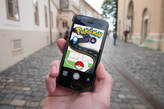 Image by Stux Image by Stux Whenever I’ve been asked what exercise someone should do, my response is always along the lines of: do something you enjoy. You are more likely to stay physically active if you actually like the activity you’re doing. For me, my favourite way to move is walking. I walk a lot. Always have, always will. For the record, though, I also engage in strength training twice a week, various functional fitness workouts weekly, as well as more cardio-focused options like running and bicycling on a regular basis. But walking is still my favourite mode of physical activity. Having said that, even I find walking a challenge in poor weather conditions. Our winters can be long, snowy, cold, icy, and unpredictable. Last year, I purchased a one-month’s pass to an indoor running track towards the end of the winter to keep me moving. This year, I wasn’t feeling the need to run, so I didn’t repeat this purchase. Yet I knew that I needed some added motivation for my walks, which led me to Pokemon Go. First released in 2016, “Pokémon GO is a 2016 augmented reality (AR) mobile game, part of the Pokémon franchise, developed and published by Niantic in collaboration with Nintendo and The Pokémon Company for iOS and Android devices. It uses mobile devices with GPS to locate, capture, train, and battle virtual Pokémon, which appear as if they are in the player's real-world location.” On January 1st, I downloaded the game to my phone and got walking. And let me tell you, it’s been so much fun. And it’s keeping me consistent with my step count year over year. Pokémon GO has helped promote physical activity for people of all ages, including teens who love to play video games. I hope you are able to find a suitable motivation to get moving every day. For now, I will bid you adieu. It’s time for me to go for a walk and catch some Pokémon.
Remember: move more, feel better. Check out the world of Pokémon here.
Exercise is a subset of physical activity that is: planned, structured, repetitive, and for the purpose of conditioning the body. It is safe to say that all exercise is movement, but not all movement is exercise. And that’s okay, because physical activity lies on a continuum, it’s not an all-or-nothing endeavour. I refer to this continuum as NEAT™ to Elite. What’s the alternative to exercise? NEAT™, non-exercise activity thermogenesis, or incidental activity. NEAT is all the ways your body burns energy that is not eating, sleeping, or dedicated exercises. NEAT relates to moving about in daily life. These small, brief muscular movements are just as important as that gym workout in burning calories. You need both exercise and non-exercise activity in your life, but it’s that non-exercise activity that we have lost in our daily lives. That movement has been replaced by appliances and apps—labour-saving devices that have robbed our bodies of the physical activity, or labour, that we used to do on a daily basis before the technological revolution made movement almost obsolete. NEAT™ is different than your workout at the gym because it relates to moving about in daily life. Research suggests that light physical activity like NEAT™ is as beneficial to older adults and previously sedentary individuals as more vigorous exercise is for younger and more physically fit Canadians. Our grandparents’ generation didn’t need fancy gym equipment or flashy workout gear. Their lives required more movement than our current way of living. There were no labour-saving devices like garage door openers, TV remotes, and online shopping. They didn’t outsource physically demanding tasks like housework and snow shovelling. They just moved—a lot. Looking at the other end of the physical activity continuum—i.e., vigorous exercise, or what I refer to as elite—tends to be associated with amateur and professional athletes. Even at the elite level, athletes are paying attention to the continuum of physical activity and adapting their training accordingly. They balance high intensity and lower intensity workouts on a daily basis; their “zero to 60” performance only kicks in at specific times. Only a small fraction of their training and competition time is spent at the high-performance level. Here’s how elite triathlete Patrick Smith explains it: “You have to find a balance. You can train at a nine or 10 but you have to be able to come back the next week, the next month, and stay injury-free.” They pace themselves, and so should you. Our bodies need both exercise and non-exercise activity every single day. Physical activity at any intensity helps prevent and manage chronic health conditions like heart disease, type 2 diabetes, and some forms of cancer. It also improves your mental health, by curtailing symptoms of anxiety and depression, and improving overall well-being. Physical activity that is accumulated in sporadic bouts throughout the day still reduces the risk of early death. Just because you can’t make it to the gym doesn’t mean you can’t be active. Rethink your activities: Go for a walk, play with your kids or grandkids, clean the house, or do some gardening. These are small steps that can lead to big change, because they get your body moving—to be physically active. About Move More, Your Life Depends On It: Need help fitting physical activity into your daily routine? Learn how to embed healthy habits into each day and improve your overall wellbeing. If you like accessible convenience, approachable information, and making a change for the better, then you’ll love this handy guidebook. Order your copy today! 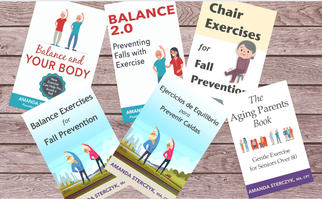 In the past week, I’ve had three separate requests for more details on the seniors’ exercise guides I have published. To date, I have written and published 6 books focused on helping seniors prevent life-altering falls and stay in their own homes longer. While there is some crossover with the books, each one has a unique focus. This month’s blog post will focus on these 6 books, but you can see a snapshot of all my books on my recently-updated website. These books are self-help exercise guides for caregivers, family members, and, most importantly, seniors. They all feature foundational exercises with step-by-step instructions and illustrations that they can use as a home-based exercise plan. The exercises don’t require special equipment or the need to get on the floor—any lying-down exercises are safe to perform on a bed. Each exercise also includes modifications on how to make it easier—or harder, in some of the more advanced books—depending on abilities. Falls are the leading cause of injury, emergency room visits, and hospitalizations for seniors in North America. The goal with my books is to help seniors increase their confidence—after all, the fear of falling contributes to the risk of falling—and improve their strength and balance so they won’t sustain a life-altering fall. Some of these titles are available for sale in Ottawa, while all of them can be ordered online from Amazon. And you can check out the table of contents with Amazon’s “Look Inside” feature if you want more details. Foundations of Balance and Fall Prevention (2-book series). The books Balance and Your Body and Balance 2.0 are standalone books, but can also be purchased together as the Foundations of Balance and Fall Prevention series. Both books are divided into three sections: The Problem, The Solution, and The Action Plan, which include a background on falls and fall prevention, personal stories, and targeted exercises. 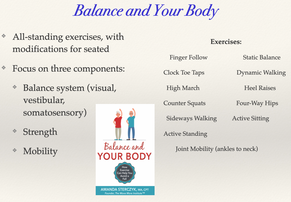 Balance and Your Body features all-standing exercises, with modifications for seated options where possible. It focuses on three components:
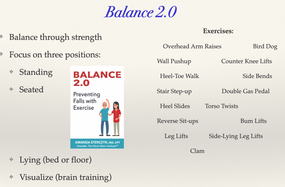 Balance 2.0 focuses on balance through strength. It features exercises in three positions: - standing - seated - lying (bed or floor) Also included are visualizations to help with brain training. Balance Exercises for Fall Prevention 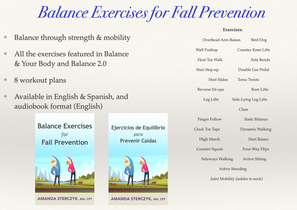 Balance Exercises for Fall Prevention is available in English and Spanish, and there is an audiobook of the English version. If you want just a straight exercise guide, this book has all the exercises featured in Balance and Your Body and Balance 2.0, while the background information on falls and fall prevention has been removed. It also includes 8 workout plans and an exercise breakdown by goal—balance, posture, strength, and flexibility. Chair Exercises for Fall Prevention 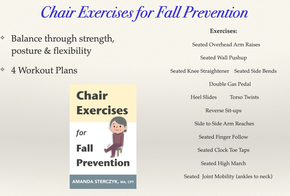 Chair Exercises for Fall Prevention features seated exercises only and includes 4 gentle, seated workout plans that focus on balance, posture, strength, and flexibility. The Aging Parents Book 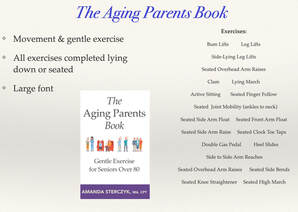 The Aging Parents Books: Gentle Exercise for Seniors Over 80 is a movement and gentle exercise guide. All of the exercises in this book are completed lying down on a bed or seated in a chair. The font size has been increased and the font style has been changed, to improve readability for those with eyesight challenges. If you’re still unsure about which book is right for you, or have any other questions, please feel free to reach out.
Introduction Inactivity can be a vicious cycle, particularly for frail, older seniors. Fear of falling keeps some seniors from getting up and moving more. Unfortunately, lack of movement further weakens muscles, stiffens joints, and reduces the ability to balance. The Aging Parents Book is a movement and gentle exercise guide. The purpose of this book is to show you, or your older loved one, how to do gentle movement-based exercises that will both feel good AND improve mobility and strength, as you (they) go about daily life. This is the sixth exercise book for seniors that I have published. It is different than my other Balance exercise guides, in that all of the exercises are completed either lying down or sitting in a chair. They still address the balance system, strength, posture, and joint mobility. These exercises will improve walking, reinforce good posture, and enhance ease of movement during day-to-day life. This book is all about gentle, low-key movement, so unlike my previous guides, there are no additional instructions on how to make the exercises harder. The font size has been increased and the font style has been changed, to improve readability for those with eyesight challenges. Exercise Sample: Foot Alphabet Copyright: Amanda Sterczyk 2023, all rights reserved.
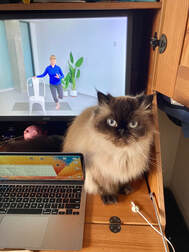 My trusty exercise assistant My trusty exercise assistant Recently, a former student reached out to ask if I’d be willing to teach an Essentrics session for her and a few friends. I spent more than a decade teaching Essentrics in the Ottawa area, but it’s been a few years since I taught a group fitness session. So I thought about it for a few days—specifically, the work involved in setting up and preparing for classes again. In the end, I politely declined and directed her to other possibilities. I no longer teach Essentrics, but it’s still a part of my life. Even before I began the instructor certification process, I had been following the Classical Stretch by Essentrics episodes and DVDs for almost 10 years. It’s a no-impact, (mostly) equipment-free workout that can be done anywhere, and I still include it in my repertoire of exercise. That’s the key for me: it’s part of my exercise options, but it’s not the only one. I believe that variety is the spice of life when it comes to exercise. You see, I don’t live to exercise—and I didn’t either when I was a full-time fitness professional—rather, I exercise to live. As I get older, I appreciate more the importance of switching up workouts to avoid overuse injuries, keeping your brain in the game by learning new things, and making sure that I’m enjoying what I’m doing. So, I do still practice Essentrics, but much less frequently than when I was teaching multiple weekly classes. For the itinerant exercise consumers like me, I offer the following recommendations for incorporating Essentrics into your life. Miranda’s books. Miranda Esmonde-White is the brains, heart, and soul behind Essentrics and is a true Canadian fitness pioneer. She has penned several books on the Essentrics technique, and these are presented below:
No matter how you choose to move your body, please do it often. It will help you in the long run. NOTE: I am no longer an Amazon Associate, so I don't earn commissions from recommended products.
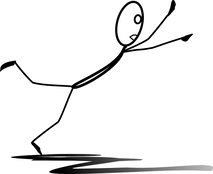 I fell this morning. Correction: I tripped and fell. While I was running. I’m okay, thanks for asking. Just a bit stiff and sore, but I’ll survive. No broken bones and I thankfully didn’t hit my head, so no concussion either. Here’s how it (I) went down: It was early. It was dark. I was tired. I didn’t notice the uneven sidewalk. I didn’t lift my foot up enough—I was tired, remember? And then it happened. It happened so fast, I didn’t even realize I was falling. So I didn’t have time to try and prevent myself from hitting the pavement at full force. All of a sudden, I was on the ground thinking to myself, “What just happened?!” That’s the problem with falling: when it happens, it happens fast. You often don’t have enough time to react. And as we get older, our reaction times slow down even more. Coupled with the fact that our bones can become more brittle, falls in older adults can be life-altering. In some cases, falls can be life-threatening. According to the Canadian Institute for Health Information (CIHI), falls account for 80% of seniors’ injury hospitalizations. Those same seniors make up half of the injury hospitalizations in Canada. That means when a senior falls, they’re more likely to be severely injured. And if you’ve fallen once, you’re more likely to fall a second time within the next 18 months. These life-altering falls reduce a person’s independence—they often can no longer stay living in their own home. What’s the solution? Avoid falling. I’m not being facetious: fall prevention is a big deal and can mean the difference between injury, hospitalization, even death. Simple exercises that don’t require special equipment, fancy clothing, or sweating. They can be done in your own home. Ideally, they should be done every day to improve balance, coordination, and mobility. These exercises increase muscle and bone strength, as well as posture—which is important to avoid a momentum-based fall. Not sure where to start? I’ve published 5 books of balance exercises for fall prevention:
As an Amazon Associate I earn from qualifying purchases.
It's clear that fall prevention is more important than ever. But, how can we reduce the risk of falls and stay active and independent as we age?
The answer is simple: balance exercises. Regular exercise is essential for maintaining strength, flexibility, and balance, which are all critical factors in reducing the risk of falls. The problem is that many older adults struggle to find an exercise routine that is safe, effective, and easy to follow. That's where my new audiobook, Balance Exercises for Fall Prevention, comes in. Fall prevention is about maintaining independence in our golden years. This allows you to stay in your own home longer. Balance Exercises for Fall Prevention is a comprehensive guide to the best balance exercises for seniors. Whether you're a beginner or an experienced exerciser, this audiobook provides a wide range of exercises that are easy to follow and can be done from the comfort of your own home. With clear instructions, helpful tips, and modifications for different abilities, you'll be able to tailor your workout to meet your needs and achieve your goals. One of the best things about Balance Exercises for Fall Prevention is that it's an audiobook, so you can listen and follow along while you exercise. This makes it easy to stay focused and motivated, even when you're feeling tired or uninspired. With regular use, you'll see improvement in your balance, coordination, and overall health, and you'll have the peace of mind of knowing you're reducing your risk of falls. So, why wait? Start your journey to better balance and fall prevention today with Balance Exercises for Fall Prevention. Whether you're looking for a comprehensive exercise program, a way to stay active and independent, or simply a way to improve your overall health, this audiobook has everything you need. Try it for free with a 30-day, no-cost trial of Audible. 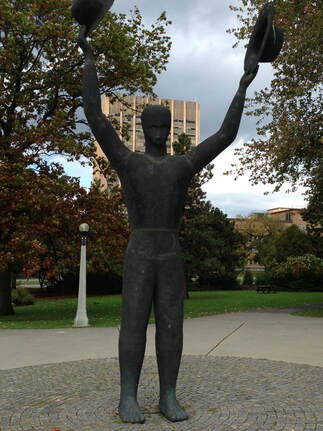 "The Man with Two Hats" by reated by Dutch artist Henk Visch. Seen by the author on regular walks in Ottawa. "The Man with Two Hats" by reated by Dutch artist Henk Visch. Seen by the author on regular walks in Ottawa.
It’s another new year, which some see as an opportunity to change their behaviour and incorporate healthy new habits into their daily lives. Can you relate? Have you set a new year’s resolution to, for instance, join a gym and get fit? When I used to teach group fitness classes, I’d often see a bump in attendance figures at the beginning of a new year.
Instead of new healthy habits, I’m pausing a long-standing habit. This new year, I’m taking a break from exercise. You can too and still feel good about yourself and your physical wellbeing.
Let me explain. Although I’m not exercising per se, I’m still staying physically active. How is it that possible, you ask?
Physical activity is not an all-or-nothing thing. In fact, physical activity lies on a continuum, from NEAT to elite. Let me break it down with a few definitions first.
Physical activity encompasses all activities, at any intensity, including exercise. What’s the alternative to exercise? NEAT, non-exercise activity thermogenesis, or incidental activity. NEAT is all the ways your body burns energy that is not eating, sleeping, or dedicated exercise.
NEAT relates to moving about in daily life. Our bodies need both exercise and non-exercise activity, but much of that non-exercise activity has been lost to technology and labour-saving devices.
So, you see, I’m taking a break from exercise, but I’m still moving lots every day. My exercise break isn’t permanent; it’s just a temporary pause while I recover from an injury. I’m still staying physically active with lots of NEAT/incidental activity, because I know that all activity leads to benefits for both physical and mental health. That’s because I don’t live to exercise; I exercise to live. And I want to live a long time.
If you’re not up to joining a gym this month, if you don’t want to live to exercise, you don’t need to. Let’s reframe physical activity: All exercise is movement, but not all movement is exercise. No special equipment, change of clothing, fancy exercise sequences, or location changes are required to just get off your butt and move more. If you move more, you will feel better. Guaranteed. Want more tips to help you incorporate non-exercise activity into your life? Check out my first book, Move More: Your Life Depends On It. |
Categories
All
Archives
July 2024
AuthorAmanda Sterczyk is an international author, Certified Personal Trainer (ACSM), an Exercise is Medicine Canada (EIMC) Fitness Professional, and a Certified Essentrics® Instructor. |


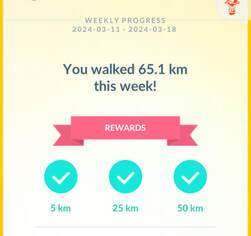

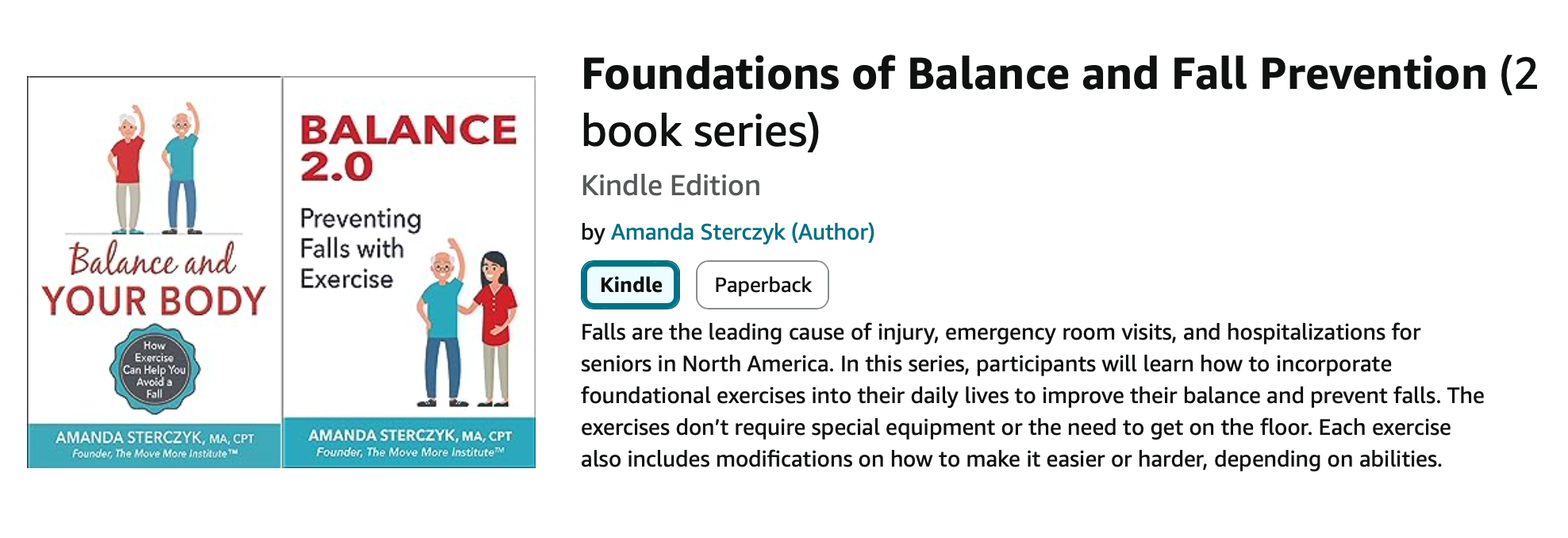
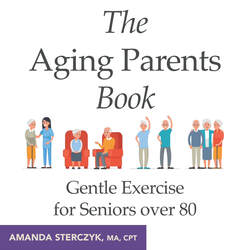
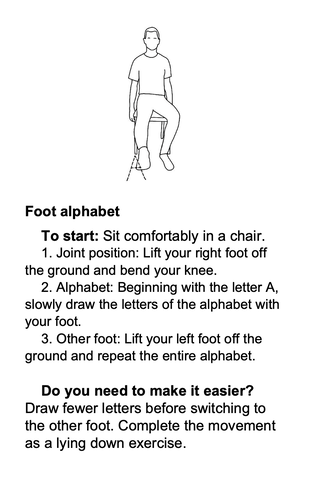
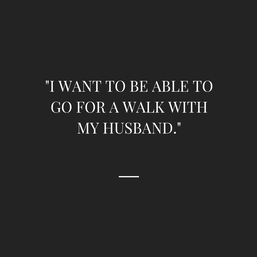
 RSS Feed
RSS Feed